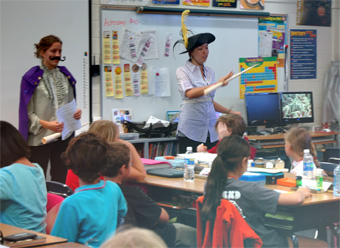 How do you say ‘science rocks’?” asks fifth-grader Asha Penprase. Scripps students Ilona Phipps-Morgan ’12 and Julia Berryman ’12 consider for a moment before providing the French translation. They may be less than ten blocks from the Scripps campus, but their experience teaching elementary-school students as part of “Core 3: Foreign Language and Culture Teaching Clinic” is light years away from their everyday college life.
How do you say ‘science rocks’?” asks fifth-grader Asha Penprase. Scripps students Ilona Phipps-Morgan ’12 and Julia Berryman ’12 consider for a moment before providing the French translation. They may be less than ten blocks from the Scripps campus, but their experience teaching elementary-school students as part of “Core 3: Foreign Language and Culture Teaching Clinic” is light years away from their everyday college life.
“I chose this Core 3 class because it seemed appealing to go into the community,” explains Ilona, who is deciding among engineering, economics, and philosophy for her major. “It’s more than an academic class. I’m considering joining the Peace Corps after graduation, so I thought it would be useful to have some teaching experience.”
As part of the Core Curriculum, all first-year Scripps students take Core I: Culture, Knowledge, and Representation, a lecture/discussion course taught by a dozen faculty. After taking this foundational course together, students choose an interdisciplinary Core II course for their second semester. Topics range from “The Detective and the City” to “Once Upon a time: Literary and Psychological Approaches to the Fairy Tale,” to “The Science and Poetry of Sleep.” As sophomores, students complete the last Core class, a Core 3 seminar that is more experiential and project-based, enabling students to spread their academic wings and produce their own research, exhibit, performance, or project.
Thierry Boucquey, Professor of French, has been offering the popular Core 3 Teaching Clinic for 12 years as a way of “making the Core real. Our students can impart knowledge by representing a foreign culture to these children, making the kids aware that the world is bigger than they know.”
This year 20 Scripps sophomores are teaching in 10 elementary-school classrooms, introducing children to Chinese, French, Korean, Japanese, and Spanish. They provide much more than a language lesson, though.
“The class offers me the chance to invite kids to fall in love with a culture,” says Liz Bisi ’12, a dual major in Psychology and French, who is also teaching French. “As children, we have a narrow view of the world, and college is often the time when your mind opens to other cultures. Giving elementary-school kids this opportunity is pretty neat.”
Claire Calderon ’12, an intended Humanities and Gender and Women’s Studies dual major who teaches Spanish in a fifth-grade classroom, has a “newfound respect for teachers” after plunging into the world of pedagogy and practice. “My mom was a teacher for years and is now a high school principal. I see now how much preparation goes into lessons and how so much in the classroom is out of your control. We have to earn the students’ respect and get them to understand what we’re trying to do.”
To prepare for their classroom debuts, Core III students discuss their own perceptions of the culture they’ll be teaching and study theories of teaching. They work in pairs in the classroom and develop a relationship with the regular classroom teacher, who can step in if the kids become rambunctious. Over time, Professor Boucquey has refined the course based on his students’ feedback. He now observes and videotapes several classes each week, and the students later view and critique each others’ teaching.
“The taping is really useful,” says Ilona, “because we can’t watch the kids while we’re performing a skit, for example. It’s useful later to see their responses.”
Dressing up as two of the three Musketeers to teach the French names of body parts, designing posters of Korean ceremonial garments to teach colors — Scripps students rely on creative, interactive techniques to engage the children. In fact, in 2005, six students co-authored with Professor Boucquey 100 Games and Activities for the Introductory Foreign Language Classroom (Eye on Education, 2007).
“Whatever I do in the future,” says Ilona, “I want it to have an international aspect. It’s so important to have an international mindset, and connecting American kids to French language and culture here reflects that.”

